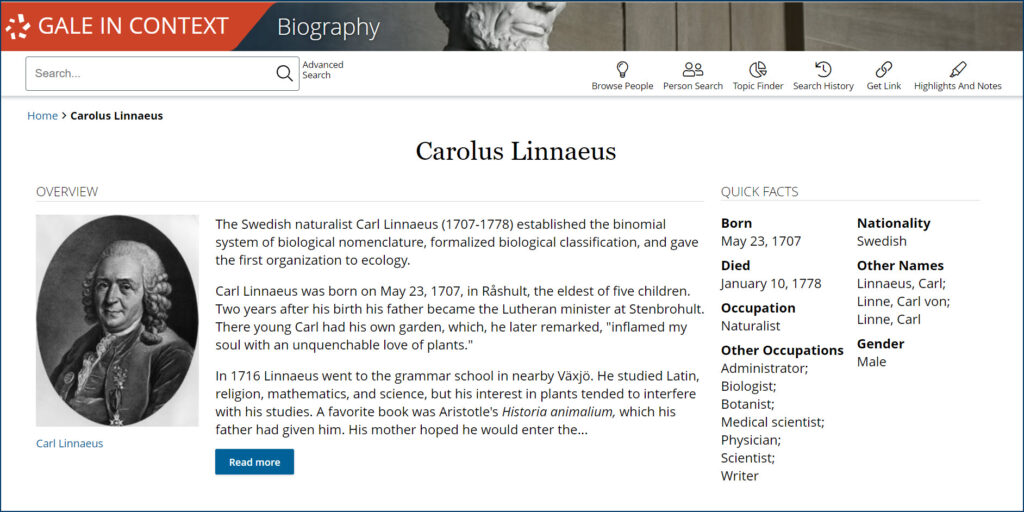| By Gale Staff |
From the noteworthy biologist Carolus Linnaeus to the pioneering astronaut Sally Ride, there is no shortage of memorable birthdays in May. To feature a few of these famous figures, Gale In Context: Biography is just the tool you need.
Biography is an engaging academic resource. Hearing the true stories behind larger-than-life figures humanizes them for students and helps them find surprising connections between themselves and their role models.
Gale In Context: Biography is a unique digital database for high school students. User-friendly and easy to navigate, this resource is designed to meet students’ needs. Each biographical portal provides a well-organized summary page and vetted, relevant resources. Information is available in various formats with embedded accessibility tools, including text-to-speech and translation features. This resource guides students’ advancing research skills while meeting the diverse needs of individual learning styles.
This May, we’re celebrating ten individuals with inspiring legacies. From singers and painters to astronauts and journalists, their lives and accomplishments transcend and enrich our recent history. With Gale In Context: Biography, you and your students can explore these captivating stories and incorporate the power of biography into your classroom year-round.
Carolus Linnaeus (1707–1778)
Noteworthy biologist, doctor, and professor Carolus Linnaeus created the system by which modern scientists categorize plants and animals, providing an ingenious classification structure for the natural world. He even assigned humans their scientific name: Homo sapiens. Linnaeus was often distracted in school by his love of gardening. However, his high school master recognized his genius and tutored him privately in botany. After attending university and earning a medical degree, he became a beloved teacher, instructing students in everything from botany to natural history to zoology to pharmacy. Today, he’s known as the father of taxonomy and a significant pioneer in ecology.
Florence Nightingale (1820–1920)
Born to a wealthy family in Florence, Italy, Florence Nightingale could have chosen a life of luxury. Instead, she dedicated herself to training in health care and catalyzed significant advancement in the nursing field. In her early 30s, Nightingale restructured the British Army’s medical services during the Crimean War. She brought much-needed funding and medical insight to the battlefront, and the death rate among wounded patients decreased by two-thirds. Her careful observations and teachings, notably around sanitation and organizational protocols, are vital to modern medicine.
Nellie Bly (1864–1922)
Elizabeth Cochrane Seaman (pen name Nellie Bly) worked undercover as a journalist to expose the injustice and abuse that working-class people experienced in U.S. cities. Bly, a below-average student, nonetheless had a real writing talent. Hardworking and ambitious, she broke the traditional female career expectations of the period to make her living as a writer. Her bold style and unique perspective landed her a job as a reporter by the time she was 21 years old. From unsafe factory work and insane asylum conditions to a race around the world, Bly never backed down from a challenging story. She fought for credibility as a reporter in an otherwise male-dominated field and helped pave a path for other aspiring female journalists.
Martha Graham (1894–1991)
Considered one of the 20th century’s most gifted dancers, Martha Graham pioneered the modern dance industry. She began dancing professionally at age 22 and continued performing and choreographing well into her 70s. Her career is particularly noteworthy because, while receiving a more traditional dance education, she created a unique dance genre and instructed hundreds of students in her memorable style. Graham’s dancing was bold and expressive, inciting a deep emotional response in her audience; she once said, “Movement is one speech that cannot lie.” In addition to her impressive legacy of 180 works, Graham was the first dancer to perform at the White House, after Eleanor Roosevelt invited her in 1937. In 1976, President Ford awarded her the Presidential Medal of Freedom, calling her a national treasure.
Bob Hope (1903–2003)
A true Renaissance man, Bob Hope could do it all. He was born one of sevensons and he spent his childhood in Cleveland, Ohio, doing what he could to stand out from the crowd. The young Hope could sing, dance, act, and joke, but his big break didn’t occur until his mid-20s when he took a short-term job as master of ceremonies at a vaudeville house in Chicago. His one-liners stole the show, and he started touring the country. In 1938, he began what would become a 20-year commitment with NBC as the star of the renowned Bob Hope Show. Hope performed for U.S. military troops serving in World War II and other wars throughout the 20th century. In 1997, Congress named Hope the nation’s first “Honorary Veteran.”
Salvador Dalí (1904–1989)
Salvador Dalí was an eccentric Spanish painter who created some of the world’s most imaginative artwork. Categorized as a Surrealist, Dalí’s personality was just as whimsical as his painting style. As a teenager, his natural artistic ability earned him a spot at the National School of Fine Arts in Madrid. After getting expelled (more than once), Dalí continued pushing the boundaries of his art and, by 1929, found success in the prestigious Parisian gallery world. He was an outrageous showman with countless hilarious anecdotes attached to his life, such as his affinity for exotic pets (he had an ocelot named Babou). Even after his death, his name still appears in curious news stories, whether a scandalous paternity claim or an uncovered treasure.
Audrey Hepburn (1929–1993)
One of the most famous actresses of the 20th century, Audrey Hepburn, was also an activist and a humanitarian. She was born in Belgium, and when she was just a child, her father left the family. Under Nazi occupation during World War II, Hepburn is said to have served as a messenger and resistance fighter for the Allies. After the war, she moved to England to pursue her budding dance career, where she was soon discovered and cast in the stage adaptation of Gigi. By her early 20s, Hepburn had won an Academy Award and went on to appear in dozens of films. However, despite her stardom, she never forgot her roots. In 1988, she became the goodwill ambassador for UNICEF and spent the rest of her life raising awareness for children in need worldwide.
Lorraine Hansberry (1930–1965)
A renowned playwright, Lorraine Hansberry’s most famous work, A Raisin in the Sun, was the first show on Broadway produced by an African American woman. Born in Chicago, Hansberry was also a prominent civil rights activist, and she used her art as a platform to address the injustices that working-class African American families faced. During her childhood, Hansberry’s parents accrued enough money to move the family into a larger home in a predominantly white area that proved unwelcoming. She experienced the trauma of an angry mob at her front door—and indifference from local authorities. She died young from pancreatic cancer, but in her short career, she helped shine a light on challenging societal tensions and changed the theatre industry forever.
Stevie Wonder (1950–)
Few musicians are as well-known as Stevie Wonder. Born Stevland Judkins Morris on May 13, 1950, he was blind from birth. His mother, who largely raised her six children on her own, moved the family to Detroit. As a child in the Whitestone Baptist Church Choir, Morris’ musical ability was already catching people’s attention. Recognizing the young man’s natural talent, a friend connected Morris to Detroit’s Motown Records label, and by age 13, the newly named Stevie Wonder had a hit song on the U.S. charts. By age 20, he met then-president Richard Nixon and became an icon for Americans with disabilities. Throughout his stunning career (including 25 Grammy Awards), Wonder has been an outspoken activist for gun control and civil rights.
Sally Ride (1951–2012)
Sally Ride is one of the most famous women in STEM. Her passion led her to pursue a double major at Stanford University, a B.S. degree in physics and a B.A. degree in English. She stayed at Stanford, but while pursuing her Ph.D., she answered an advertisement for “mission specialists” from NASA. By 1983, Ride had become the first U.S. woman in outer space. Her success in such a highly competitive, male-dominated field demonstrates her courage and perseverance.
Join us in wishing “Happy Birthday” to this amazing group in May as we celebrate their accomplishments. With Gale In Context: Biography, the stories are endless—the database houses more than 5,000 dedicated biographical portals for people of note. Students can find role models in these archives—and you can feel confident in Gale’s reliable research and accessibility tools. Inspire your students’ curiosity this May.
If your institution isn’t a Gale In Context: Biography subscriber, learn more or request a trial today.



